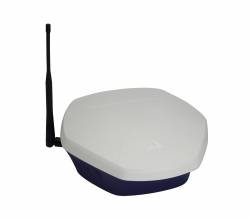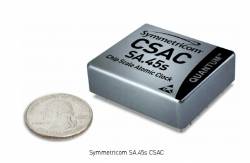NovAtel Announces SMART-MR15 GNSS Receiver/Antenna/Cellular Modem
 NovAtel SMART-MR15
NovAtel SMART-MR15NovAtel Inc. has released its new SMART-MR15 product, a dual-frequency receiver/antenna combination with an integrated cellular modem.
By Inside GNSS NovAtel SMART-MR15
NovAtel SMART-MR15NovAtel Inc. has released its new SMART-MR15 product, a dual-frequency receiver/antenna combination with an integrated cellular modem.
By Inside GNSS Pendulum GSG-55 Simulator
Pendulum GSG-55 SimulatorSpectracom has announced its new 16-channel GPS constellation simulator, the Pendulum GSG-55.
The latest in the Pendulum line of GPS receiver test instruments, the GSG-55 is able to simulate Satellite-Based Augmentation Systems (SBAS), such as the U.S. Wide Area Augmentation System and the European Geostationary Navigation Overlay Service (EGNOS).
By Inside GNSS Collaborative Human Immersive Laboratory (CHIL) illustration (Lockheed Martin)
Collaborative Human Immersive Laboratory (CHIL) illustration (Lockheed Martin)GPS III contractor Lockheed Martin has integrated several virtual reality technologies in a new Collaborative Human Immersive Laboratory (CHIL) in Littleton, Colorado, which will be used to validate and test next-generation GPS and other space programs.
With CHIL, Engineers and technicians can explore satellite designs and functions, troubleshoot and fine-tune them in a virtual world before building them in physical space.
By Inside GNSS
After eight years of successful participation in the Defense Advanced Research Projects Agency (DARPA) chip scale atomic clock (CSAC) initiative, Symmetricom, Inc., announced today (January 18, 2011) the general availability of what it says is the world’s smallest, lowest power atomic oscillator: a 16 cubic-centimeter unit weighing less than 35 grams (about 1.25 ounces) and operating on only 115 milliwatts of 3.3 VDC power.
By Inside GNSS
Spirent Communications, long established in the laboratory test marketplace with its line of navigation and positioning simulators, has extended its product development into real-world environments by introducing a GNSS record and playback system (RPS).
By Inside GNSS
NavCom Technology, Inc., has announced new capabilities for the SF-3050 multi-frequency GNSS receiver and Sapphire GNSS OEM board.
In addition to the integrated StarFire/real-time kinematic (RTK) GNSS capabilities, the SF-3050 and Sapphire now support single-frequency, multi-constellation operation, heading, and moving base station RTK operation that enables coordinated vehicle applications.
By Inside GNSS
Topcon Positioning Systems (TPS), Livermore, California, has announced the addition of the IP-S2 HD Mapping System to its line of mobile mapping solutions.
The IP-S2 HD is a vehicle-mounted surveying and mapping system featuring a high-definition LiDAR scanner from Velodyne Lidar, Inc. The system incorporates high-precision GNSS receivers, an inertial measurement unit, vehicle wheel encoder, 360-degree digital cameras and Velodyne’s HDL-64E S2.2 LiDAR scanner.
By Inside GNSS Calgary, Alberta: Canadian high-tech center and home to rivals NovAtel and Hemisphere GPS
Calgary, Alberta: Canadian high-tech center and home to rivals NovAtel and Hemisphere GPSTwo Canadian companies — NovAtel and Hemisphere GPS — that over the years had positioned their products somewhat separately along the GNSS OEM technology spectrum appear to be moving toward a more head-to-head competition.
By Inside GNSS Eclipse II GNSS OEM Board
Eclipse II GNSS OEM BoardHemisphere GPS announced its next-generation Eclipse II GNSS receiver technology today (September 8, 2010) and the release of the Eclipse II OEM board.
By Inside GNSS
Hemisphere GPS has signed a multi-year exclusive agreement to supply the S3-S Navigator — a customized Outback S3 precision guidance system — for Summit Liability Solutions. Both companies are based in Calgary, Alberta, Canada.
By Inside GNSS
Applanix recently released Version 5 of its Position and Orientation System for Land Vehicles (POS LV).
According to the company, the system uses integrated inertial technology and is designed to generate stable, reliable and repeatable positioning solutions for land-based vehicle applications such as road geometry, pavement inspection, GIS database and asset management, road surveying and vehicle dynamics. The company says the unit is designed to operate under the most difficult GPS conditions in urban and suburban environments.
By Inside GNSSBaseband Technologies Inc., of Calgary, Alberta, Canada, recently announced the launch of its Deep-R technology, which the company says is capable of capturing a GPS position using two milliseconds of I/Q samples.
By Inside GNSSNovAtel Inc. recently announced the release of Version 1.011 firmware for its L1 OEMStar GNSS (GPS+GLONASS+SBAS) receiver, which the company says is designed to provide improved PDP and GL1DE filter performance, improved satellite tracking in low signal level environments, improved satellite-based augmentation system (SBAS) performance when operating outside of the standard grid map, and improved time to first fix.
By Inside GNSS